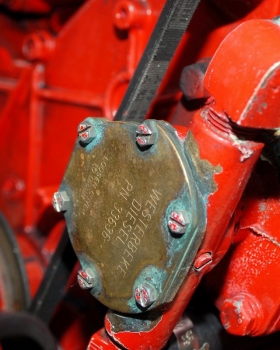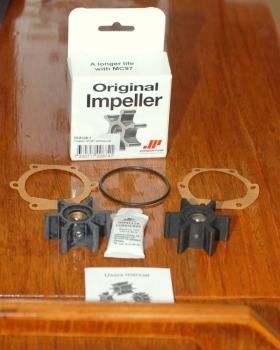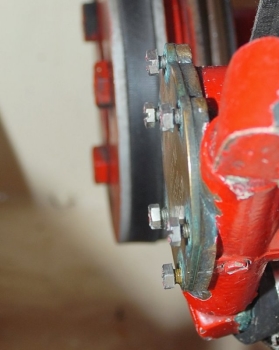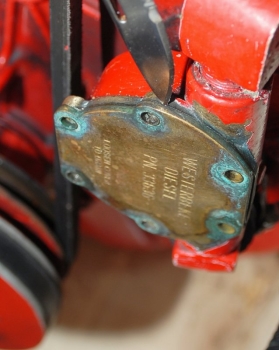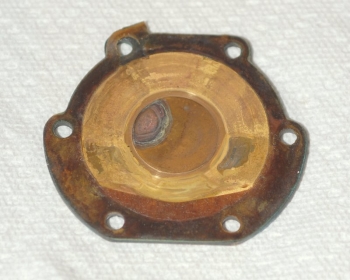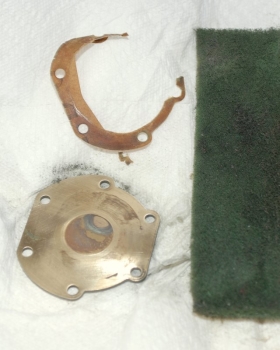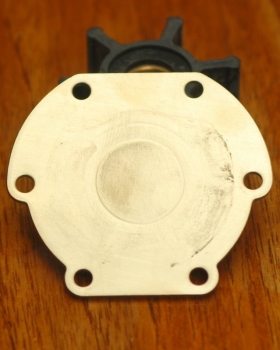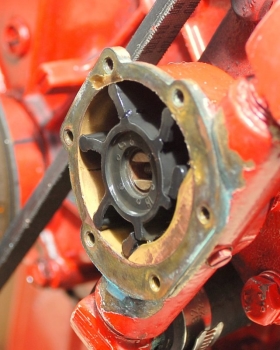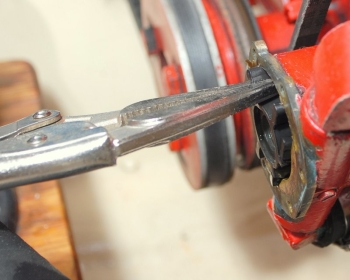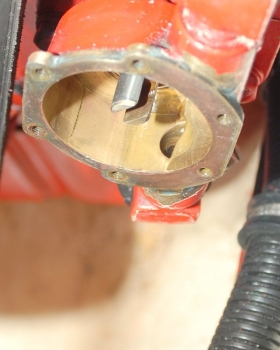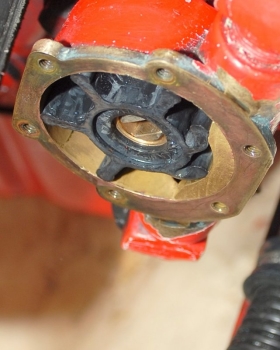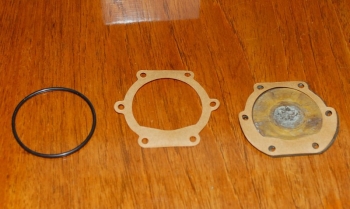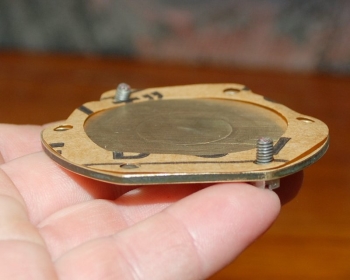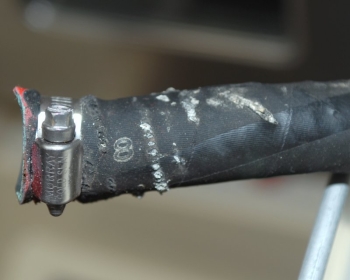The Raw Water Pump
Changing an impeller is not a daunting task and it’s one that every boater should consider adding to their arsenal of DIY maintenance. Changing an impeller, on many engines, usually takes less than 20 minutes even if you are fairly slow. The most complicated aspect of the task is physical access to the pump.
Raw water impellers are a wear item unfortunately they do not always abide by a time or hours of use schedule. A simple mishap like forgetting to open the engines raw water intake, or a partial weed plug in the intake, can kill an impeller in short order. Impellers don’t like to be run dry and they don’t like heat. If run hot for too long they can throw a blade or lose a chunk that can lodge in a hose, elbow or in the heat exchanger. If this happens you’ll have a much larger job on your hands in terms of finding the missing piece. Finding all the missing impeller bits is important in order to prevent further damage or overheating issues.
I change my impeller every spring regardless of condition. Some feel this is overkill and you’ll need to decide for your self what your maintenance schedule is. I look at it this way, impellers are cheap insurance. I pay $16.00 for the impeller in our Westerbeke and it takes about 8-10 minutes to change it. It took me just twenty minutes, even while photographing it, and the access for my large camera was not very conducive..
An over heated engine or a thrown blade can cost many, many times more in both time and money than the few minutes and the minimal boat bucks required for this simple maintenance. Changing an impeller costs less than changing my engine oil and filter..
If you do it every spring, or every time you run it dry for more than a 30-45 second period, or under restricted flow due to a blockage in the strainer or intake system, you should have a trouble free impeller and never throw a blade or lose flow due to a worn impeller again.
New Impeller Kit
This is the impeller kit I use in my engine. It comes complete with gaskets, instructions and impeller lube which is nothing more than glycerin.
If you notice, the impeller box does not say Westerbeke on it. Westerbeke uses a Johnson pump on this particular engine and Hamilton Marine stocks the exact impeller kit for it. They may for your engine too.
The impeller on the left is the brand new one and the one on the right was removed last fall after winterizing the engine. I keep the old ones, that are in good condition extra spares. Sure, I could buy this impeller through Westerbeke but it costs almost $38.00 vs. $16.00 at Hamilton Marine and they are identical right down to the embossed Johnson part number on the impeller itself.
I always recommend keeping at least one fully new replacement impeller on board at all times and a minimum of two gaskets. Sometimes you’ll need to check the impeller but it may not need to be replaced thus the extra gasket or o-ring.
Removing The Screws
As I mentioned this job is very, very easy. If you can change oil or an air filter or clean a blender after making frozen chick drinks you can certainly change an impeller.
Step 1: Loosen the screws and remove them. If they are frozen or rusted use some PB Blaster but be very, very careful not to just blast it everywhere.. Please understand that PB Blaster can eat pump seals, engine seals and engine gaskets for breakfast. If you need to use a penetrating oil I’d advise spraying it into the spray can cap and then dab it on the screws with a Q-Tip.
Tip: Buy yourself some spare face plate screws as one will always wan to drop into the bilge. That Murphy guy is always waiting for you…
Pry The Plate Off
Step 2: Pry the cover plate off. I use a knife blade for this and it works fine. There are many ways to get the plate off but what ever method you choose make certain it does not harm the gasket mating surfaces.
IMPORTANT: Before you tackle this job be sure to CLOSE THE ENGINE INTAKE SEACOCK before prying off the plate or attempting to change the impeller.
Don’t get alarmed if water drains out after you pop the cover plate off. There will be water remaining in the HX and hoses. Catch it in a towel, cup or have a turkey baster, rags and or a sponge on hand to dry everything up afterwards.
Check For Wear
The face plate of a water pump is considered another wear item. If it’s scored and worn you should replace it or flip it. I keep a spare brand new cover plate on board just in case. Even at Westerbeke’s exorbitant prices it was only $13.00, and again is cheap insurance.
Some pumps, such as certain Oberdorfer models, have cover plates with no stamped part numbers on them. If your cover plate is worn, and the opposite side has no paint or stamping marks, you can simply flip it around and re-use it. My Westerbeke face plate is embossed with a part number and can not be flipped.
My paper gasket came off, except for one small chunk, in one piece. That is not by design but rather dumb luck… Sometimes you get lucky!
Clean The Cover Plate
Before re-using the cover plate you should clean it and make the gasket surface smooth again. To do this I simply use Scotch-Brite pads. Be sure to remove all traces of the previous gasket from both the pump body face and the cover plates mating face. Being diligent in your cleaning duties will minimize the potential for a gasket leak..
Ready To Re-Install
After I cleaned this plate I decided that I’d install my new one instead, and keep this as a back up. The pictured plate has fairly minimal wear and could certainly be re-used with success but for the $13.00 I decided to go new.
The Old Impeller
If you been reading, and paying attention, you’ll know that I replaced this impeller only a couple of months ago in April and now, as I write this, it’s only late July.
So why is this impeller already cracked and ruined? That’s an easy answer.
We were motoring back in zero wind on a spring tide day. Spring tides in Maine have a nice feature that involves reaching far up onto the shoreline and pulling every last bit of seaweed and deposited junk back off the beach and into the bay.
About a mile from our mooring I noticed the exhaust note change like less water was being spit out. I kept a close watch on my water temp and it only went up about 8-10 degrees above normal before we got to the mooring. The next day I went to the boat, cleaned the strainer and reamed out the intake hose between the strainer and seacock. It was certainly restricting flow but it had not been running totally dry, just pumping less volume. Clearly this was enough to heat the impeller and damage it. As always, in a situation like this, where it had limited flow, I make a habit of checking the impeller.
I was very surprised that only a few minutes of restricted flow caused this type of damage. Normally I would have stopped the boat and cleaned the strainer but the temp was not even at 190, it normally runs at 180, and we had a hungry baby on board so I pushed on.
If you run your impeller dry, or even with restricted flow, at least check on it. If it’s in good condition all it will cost you is an $.88 cent gasket. If it’s bad, as mine was, replace it. I would guess I probably had another 5-10 hours before this one started throwing chunks.
NOTE: Globe impellers are reportedly able to run dry for short periods of time however I have had two Globe impellers spin the hub and stop pumping completely. While I think the concept is great I’m a little gun shy, having had two fail me. I have also note Globe impeller failures similar to this on customers boats too. Globe impellers may be another option but do know of the failures I’ve seen and that they are almost two to three times the cost of my stock Johnson impeller.
Remove The Impeller
While the concept of water pumps is the same across brands the method of how the impeller sits on, or is attached to the shaft may be different. This pump has a slotted shaft and the impeller has a screw that sits in the slot. To remove it I simply use my needle nose Vise Grip pliers. It just pops right out and could not be any simpler.
Some pumps use set screws or c-clips. Impellers with c-clip retaining rings will require a set of c-clip pliers. It’s always good to know what your pump looks like before taking it apart so you can have the right tools on hand. Most engine manufacturers and pump makers have on-line parts manuals that will show an exploded view and will allow a sneak peek into the inside of your pump before you open it up..
Check The Pump Body
Don’t forget to check the pump body for both wear and debris. Run your finger around the inside to feel for groves or rough spots and give it a good visual inspection.
Once you have done this apply some impeller lube, AKA glycerin, to your finger and lube up the inside surfaces of the pump body including the back wall as it too is part of the impellers sealing surface. Both the rear of the pump and the cover plate should be lubed with glycerin before final assembly or insertion of the impeller.
IMPORTANT: Please do not use petroleum based greases or oils as lubes nor use silicone grease. Some petroleum greases are non-compatible with the impeller material and greases tend to get gummy in the internals. Stick with glycerin as a lube. A lifetime supply of it will run you about $3.00 at any drug store. It provides for start up lube and then washes away.
New Impeller
To install the impeller lube the entire exterior with glycerin. After lubing compress it with your fingers and seat it into the pump body..
I often hear of folks talking of using zip ties to pre-compress the impeller for insertion but I honestly don’t understand why one would need to do so. I’ve replaced impellers on very large Detroit diesels, Cummins, Caterpillars and even one lung teeny tiny Yanmar’s and all of those impellers went back in fine without a zip tie pre-compressing it. You really do not need to over think the re-insertion just do it.
If your impeller had vanes pointing in different directions when you took it out, as the photo of the old one shows, DON’T WORRY. This is rather normal and is due to the little bit of back spin a diesel can develop as it shuts down. Sometimes during the last revolution the engine may actually spin back a notch or two causing the impeller blades to be out of spin direction unison.
Even of you put an impeller in with the vanes completely backwards of the pumps rotation it would correct itself with the first bump of the starter. It is 100% urban myth/dock talk that impeller vanes need to be installed in the direction of rotation.
Pumps just like these, which use identical impellers, are used in industry every single day and the pumps are often forward and reverse pumps switching directions many times per day to drain or fill tanks, vats etc.. Please don’t beat yourself up over vane direction, it simply doesn’t matter..
Chose The Right Gasket
If you buy an OEM impeller directly from Yanmar, Westerbeke or Universal, to name a few, they usually come with the right gasket. If your impeller came with more than one gasket chose the correct gasket by matching it to your cover plate or o-ring groove.
Prep The Gasket
These cheap paper gaskets tend to suck donkey balls. (grin)
To aid the gasket in making a good seal I sometimes use HondaBond 4 (do not confuse HondaBond 4 with HondaBond HT which is silicone).
Personally I do not like silicone gasket maker for this application and much prefer products like HondaBond 4, YamaBond or ThreeBond 1104. A product called The Right Stuff from Permatex is also similar. These sealants do not totally cure, remain flexible and will not contaminate sealing surfaces with silicone.
Do not over apply any gasket sealer. You only need enough to have skim coat on the surfaces.
I like to insert two machine screws and lay the gasket over them before installation of the plate. This keeps the gasket aligned and makes it a simple one step procedure. With the two screws finger tight I then insert the remaining screws and torque them to proper spec which you will find in your owners manual. If your handy with a wrench you can do this by feel, if not, you may actually want to use a torque wrench.
You can install the gasket using any method that gets the gasket in the right place without ripping it, as that is all that really matters.. These paper gaskets can go in dry too.
Check Your Hoses
Do yourself a favor and always physically and visually inspect your hoses each time you’re in the engine compartment.
This is a wire reinforced hose that was very close to failure. Of course it was the most difficult hose to replace and the only way I could tell it was bad was by feel. The internal reinforcing wire is severely corroded and rotting through the jacket as evidenced by the white residue and bulges.
All Done
See changing an impeller is quite easy!
Good luck & happy boating!

